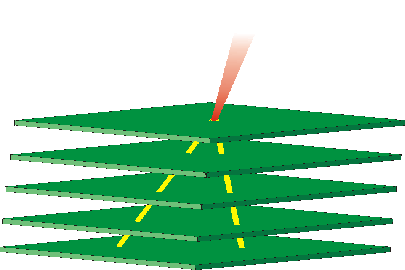



Next: Event reconstruction in pair
Up: AGILE performances optimization
Previous: The AGILE instrument
Contents
One of the main difficulties of gamma-ray astronomy from space is represented by the huge instrumental noise produced by cosmic rays and the secondaries produced by the interaction of cosmic ray and the terrestrial atmosphere.
These particles produce in the GRID instrument a signal similar to that produced by cosmic photons.
The primary cosmic rays give a rate of high energy events (between about 1 and 100 GeV) , coming from an up-down direction.
The interaction of cosmic protons with the Earth's atmosphere produces secondaries, as low energy (less than 1 GeV) protons, electrons, positrons and gamma photons.
The terrestrial magnetic field makes the distribution of protons, electrons and positrons arriving at the AGILE tracker isotropic.
The secondary gammas (the albedo photons) instead come mainly from the directions in which the line of sight crosses a larger thickness of atmosphere, namely from the terrestrial limb.
The total flux of background events is about 
 , hence several orders of magnitude larger than the cosmic gamma-rays flux.
AGILE will have a data-handling system with the scope of cutting a large part of the background rate, that otherwise would give an excessive load for the telemetry channel of scientific data.
, hence several orders of magnitude larger than the cosmic gamma-rays flux.
AGILE will have a data-handling system with the scope of cutting a large part of the background rate, that otherwise would give an excessive load for the telemetry channel of scientific data.
The remaining noise rate will be eliminated offline with more complex techniques than those usable on board.
The on-board data-handling will process the events through a triggers system consisting of a hardware and a software level.
The hardware level accepts only the events that produce some particular configuration of fired anticoincidence panels and tracker planes.
The large GRID field of view is based on the capability of this level of exploiting the tracker planes as trigger, without the necessity of other detectors as, for example, the systems of ``time of flight'' used for the previous gamma-ray missions.
This level, thanks to its simplicity, will be able of handle also high rate of events, and it will provide an output event rate of about 100 Hz.
The software level will be, in turn, composed by two steps.
In the first step it will be applied a set of simple algorithms that, analyzing the event morphology, will be able to eliminate further
the background rate (more details on this step of processing can be found in [Cocco et al., 2002]).
Nevertheless the event rate after the first software level (estimated in about 30 Hz) is still too high for the capabilities of the telemetry channel.
It is then necessary a further processing step, to eliminate the background events, particularly those produced by albedo photons, that can be discriminated by cosmic gamma-rays only on the basis of the incoming direction.
In the following paragraphs an algorithm that, carrying out a reconstruction of GRID events, is able of estimate the direction of the incident photon is presented.
Figure 4.5:
A view of the basic interaction in a pair production telescope.
 |
Subsections




Next: Event reconstruction in pair
Up: AGILE performances optimization
Previous: The AGILE instrument
Contents
Andrea Giuliani
2005-01-21
